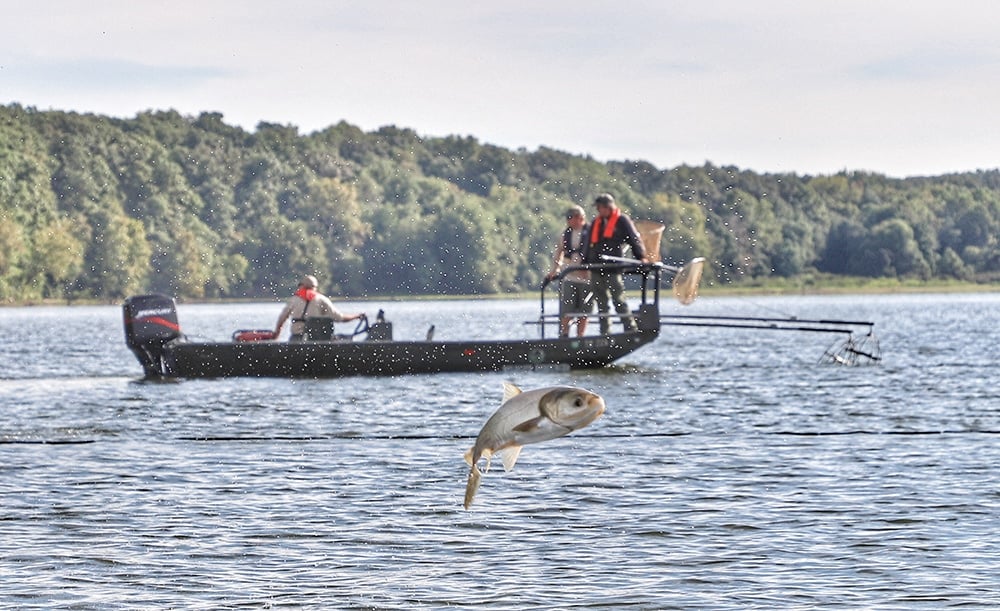How the War On an Asian Carp Could Falter Amidst COVID-19
For almost a decade, a war has been waged against Asian carp. Despite efforts supported by federal and state programs, as well as coalitions of recreational and commercial fishermen, efforts remain inadequate against what many consider the greatest invasive species problem in U.S. freshwater.
“Asian carp” refers to a collective four species of carp (silver, bighead, black, and grass), each non-indigenous fish imported from Asia as early as the sixties by scientists from the U.S. Fish and Wildlife Department who recognized their filter-feeding habits could clean farm ponds in the Ozarks.
Unfortunately, these carp proved formidable not only at aquaculture, but also breeding and migration. Facing no natural predators in U.S. freshwater ecosystems, their population exploded and extreme flooding allowed them to eventually find routes into the Mississippi River. From there, they have spread throughout the Mississippi River Basin, a drainage system that touches 32 different states.
Size and prolific breeding patterns allow Asian carp to outcompete bait fish for algae, a low but integral part of freshwater food chains. The ecological repercussions also reduce native fish populations further up the food chain, including recreational game fish such as crappie and bass.
In total, this impact has created economic difficulties for state and local economies that depend on fishing both commercially and for tourism.
This is especially true of silver carp, which has flourished in a section of the Tennessee River system that straddles both Tennessee and Kentucky. Migrating through locks above the Kentucky and Barkley Lake dams, silver carp have become synonymous with bad fishing experiences; when disturbed by anything, they jump.
“A blackbird flew over the surface of the water. The entire cove erupted with silvers… There had to be 10,000 of them,” said one Kentucky Lake resident in a “War On Carp” coalition video.
To understand why jumping poses a uniquely disruptive safety hazard, consider that silver carp have a high population density in these reservoirs, each with an average length over two feet. In their above-the-surface frenzy, Asian carp can often hit people or flop into their boats, causing problems for sportfishing.
“People don’t want to have to deal with them,” says Cole Harty, Aquatic Nuisance Species Coordinator for the Tennessee Wildlife & Resource Agency. “And one or two bad experiences can have a big impact.”
Harty has seen a decline in bass fishing within the region. He also says it’s difficult to differentiate what impact Asian carp are having on local fisheries. Nonetheless, their perception as a major ingredient for a bad fishing trip has consequences.
“It has been a financial burden on our tourism industry,” says Travis McLeese, CEO of the nearby Paris-Henry County Chamber of Commerce.
Drawing a large portion of its revenue from aquatic recreation on Kentucky Lake, McLeese says that the local economy took a significant hit in 2019.
Over the last decade, federal and state governments have poured millions of dollars into conservation efforts targeted at mitigating carp impact. Historically, the bulk of that spending has been used to prevent Asian carp from breaching into Great Lake fisheries, collectively valued at supporting 75,000 jobs and generating over seven billion dollars annually.
Using an elaborate network of underwater fences and sound barriers at key waterway “choke points,” these containment efforts have successfully stopped Asian carp from entering the Great Lakes.
However, containment in other tributaries of the Mississippi River is a far more complex project. According to Harty, the task is beyond what any one state can do.
In Tennessee and Kentucky alone, Asian carp
threaten a combined recreational fishing industry worth 1.7 billion dollars, according to the American Sportfishing Association.
Record funding for this war against carp came in December 2019 when the Trump administration signed a bill for $25 million to combat the spread of Asian carp in Southern states. Unlike previous strategies, much of this funding has gone to eradicating Asian carp where they are already abundant, such as Kentucky and Barkely lake.
The only sustainable way this can happen is by getting commercial fishermen interested in Asian carp. That has required both state-sponsored programs such as Tennessee’s Asian Carp Harvest Incentive Program (ACHIP) and finding entities who will buy carp. But unfortunately Asian carp can be a tough sell, because they are quite bony.
“That fish has a bone structure like none other,” says Christel Young, Vice President of Finance at North American Caviar, a Paris county wholesale fish buyer.
For the last several years, Young and her business partner and husband, Clay, have worked with the Tennessee Wildlife and Resource Agency (TWRA) to find a profitable outlet for Asian carp. Their struggles come from the bone structure, which is so pervasive that profitability of Asian carp meat is much lower than other fish they process like catfish. Also, unlike populations in Asia, U.S. seafood consumers do not typically eat Asian carp for this same reason.
Things changed between 2018 and 2019 when Young and her husband discovered a viable bait market for Asian carp by selling to lobster fishing companies. However, when the COVID-19 pandemic halted trade with Asia, the continent that buys between 70 to 80 percent of North American lobster, the market and price for Asian carp also took a hit.
The onset of the pandemic also brings questions as to whether government resources can continue to support these conservation efforts in light of broader health and economic issues.
Despite these obstacles, Young remains optimistic about the long term market for Asian carp as long as Tennessee’s incentive program remains. Strong local support from the Paris community shows through several grocery stores and at least one high end restaurant serving Asian carp as perhaps the most economic and environmentally conscious seafood option available.
A local cooking brand, Grange Food Company, has even produced a video showing several recipes for cooking Asian carp filets, indicating that despite perception, Asian carp might actually be delicious.
Cover photo by Amy Snider; courtesy of the Tennessee Wildlife Resources Agency








